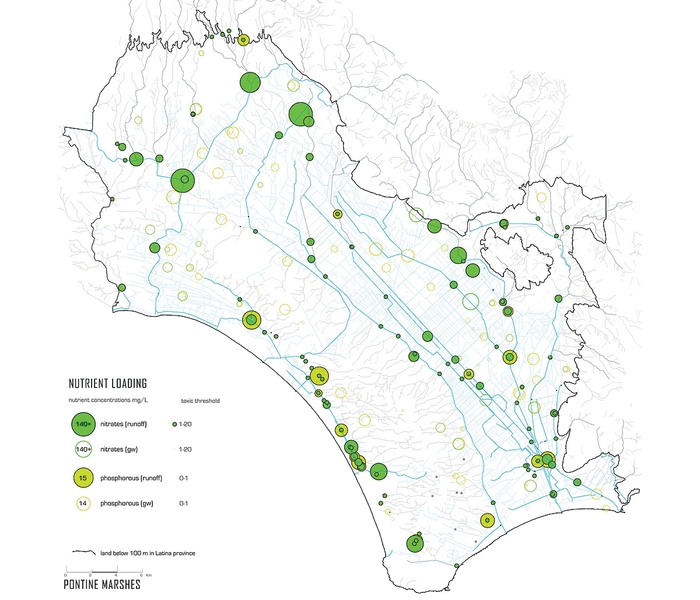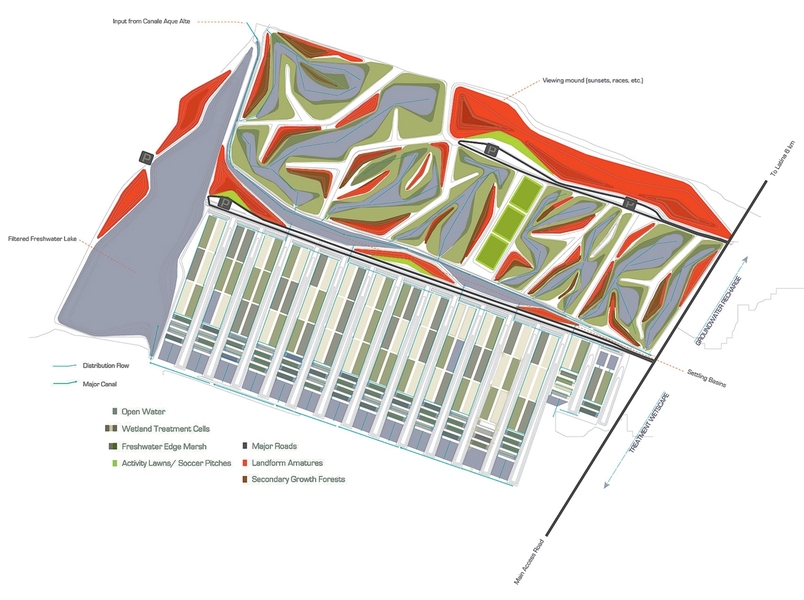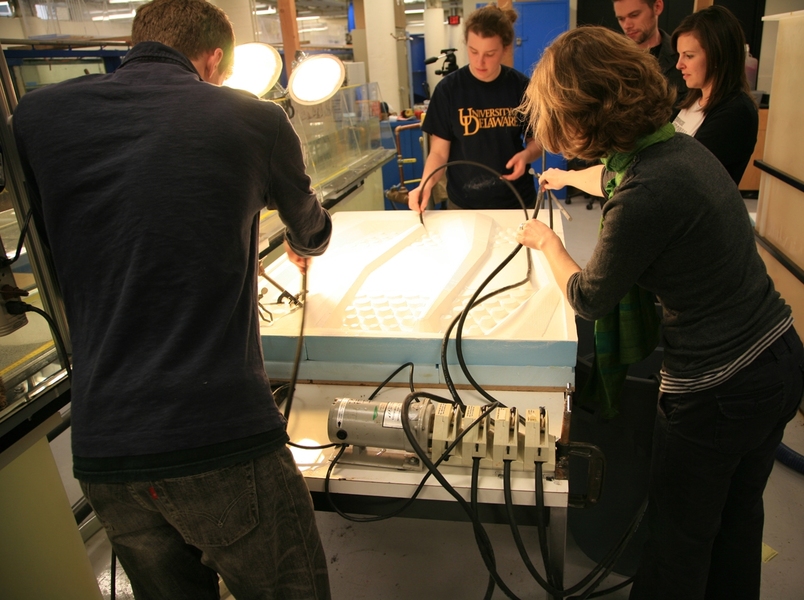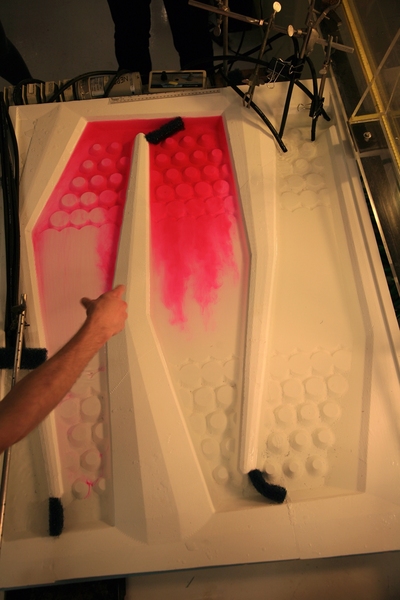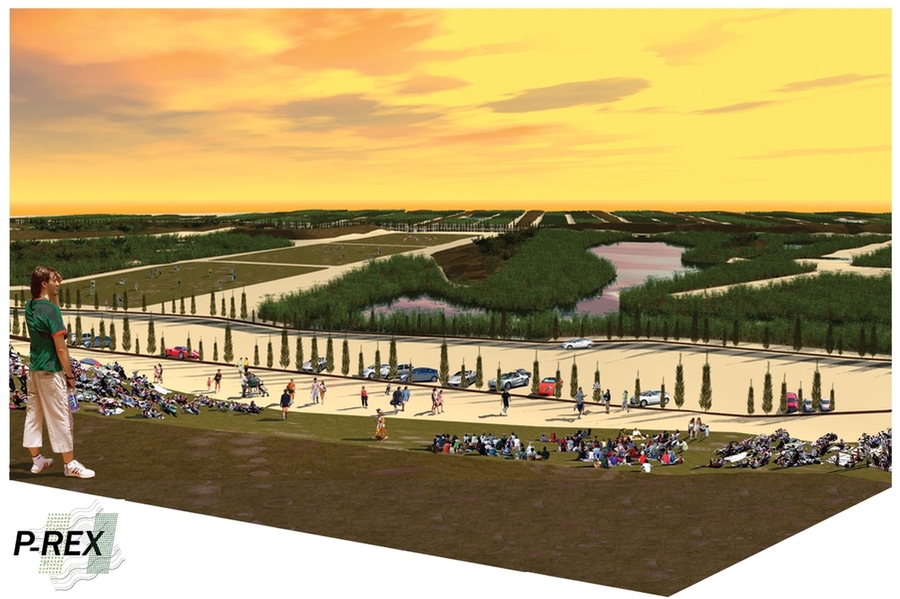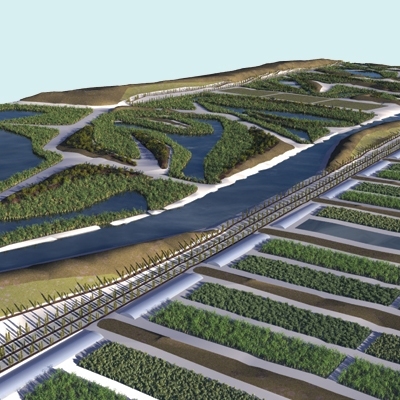Just south of Rome lie the Pontine Marshes, a vexed part of the Italian countryside. In ancient times, Roman emperors tried unsuccessfully to drain the marshes, something only achieved in the 1930s through a system of massive pumps and canals that removed enough water to turn the area into productive farmland. Yet today those canals have become heavily polluted, endangering the area’s agriculture and the health of its residents.
The conventional way of tackling the problem would be to build a series of large water-treatment plants in the area, which covers about 300 square miles. But Alan Berger, an associate professor of urban design and landscape architecture at MIT, has another idea. Because some plants absorb pollutants as water flows by them, carefully designed wetlands can clean up the countryside while preserving its natural feel and providing public park space.
Berger realized this notion could apply to the Pontine Marshes while on a fellowship at the American Academy in Rome in 2007-2008. He then began trying to persuade officials of the Italian region of Lazio, in the province of Latina, where the marshes are located, to consider the notion. Now, after performing innovative interdisciplinary testing with researchers in MIT’s Department of Civil and Environmental Engineering, Berger believes he knows how to make the concept work best. Regional officials have since become enthusiastic about the idea: In September 2009, Lazio’s government received a grant for 4.5 million euros as part of the European Union’s “Life+” program for environmental works, specifically to clean up the area using natural processes.
That represents a reversal, Berger claims, from the response he usually got when he started floating the idea in Italy. “People said I was insane,” recalls Berger, who has designed several large-scale environmental cleanup projects in his career. “But if you do good research, you can change the type of project that is done.” As Lazio’s planning director, Carlo Perotto, said of Berger in 2008: “He opened a new way of thinking.”
Why inefficiency, here, works
As the waterways of the Pontine Marshes move from inland hills to the sea, they accumulate excess nitrogen and phosphorus from fertilizer used on the adjacent farmland. That affects the crops and livestock using the water further downstream, creating potential hazards throughout the food chain.
However, water polluted in this way can be cleansed after coming into contact with the right kind of vegetation. Marsh grasses absorb toxins and effectively remove them from circulation in the ecosystem. The wetlands Berger wants to build in the Pontine Marshes would direct polluted canal water into a twisting channel with vegetation, from which the water would emerge clean.
The precise amount of pollution in the marshes varies by area and season, but in some areas near the sea, notes Berger, the canals almost wholly contain waste water. Wetlands can reduce pollution levels by over 90 percent, if wetlands provide a large enough area for the water to flow through. Berger would like to initiate the project by building an extremely large wetlands — 2.3 square kilometers — intended to clean a central artery in the Pontine canal system.
But the Pontine Marshes project constitutes an engineering problem with two key challenges. First, the water flowing through the wetlands must move slowly enough so that the plants can absorb the pollutants; second, the pattern of the water flow must give all water molecules equal opportunity to encounter the vegetation.
Berger’s solution is to have the water move through an S-shaped course that slows it down to a speed well under one mile per hour. The Italian engineers of the 1930s built perfectly straight canals, since they were simply concerned with transporting water efficiently. But forcing water to meander through winding channels in a wetlands gives more water molecules the best chance of being purified. ”Inefficiency is how environmental systems work,” says Berger.
Since Berger is not an engineer, he joined forces with Heidi Nepf, a professor in MIT’s Department of Civil and Environmental Engineering (CEE) who specializes in analyzing fluid dynamics, to test his designs. Nepf, CEE graduate student Jeff Rominger, and a Harvard graduate student, Gena Wirth, who was working for Berger’s design group, the Project for Reclamation Excellence (P-REX), built multiple models from Berger’s plans, featuring variations of S-shapes and alterations in the density and placement of the wetlands vegetation.
To scrutinize the designs, the researchers sent water injected with an fluorescent dye called Rhodamine WT through the models and used a fluorometer to measure the intensity of the light as the water exited, which indicated how broadly the water had spread. Test results indicated that the optimum design was one featuring relatively wide S-shaped channels with lots of vegetation underneath and small “islands” of earth to help the water disperse evenly.
“Heidi’s and Jeff’s work gave us a scientific understanding of how these plans functioned, and allowed us to push the design envelope,” says Berger.
Same function, new form
And while a few pollution-removing wetlands exist in the United States, Nepf says, they use identical rectangular templates plunked down regardless of the surrounding landscape’s features. “What’s novel is Alan seeing that water treatment can be made attractive,“ says Nepf. “In the wetlands treatment community, you would never go to this step.” Since the Italian countryside is a tourist attraction, she notes, eliminating stretches of concrete canals (and the need for treatment plants) “lets Italy find cultural or economic value” while improving the environment. Berger’s designs would also include park space built adjacent to the wetlands, in order to give the public better access to the countryside.
Berger’s approach to the Pontine Marshes acknowledges “that in many cases the landscape can't be returned to its original state,” says Tom Avermaete, a professor of architecture and public building at Delft University of Technology, in the Netherlands. Instead, Avermaete believes, designers should seek new ways of mending damaged landscapes: “These processes of reclamation are one of the main challenges for future architecture and urban planning.”
The collaboration between Berger and Nepf thus expands the way treatment wetlands can be built, by finding a new form for the function. Berger is currently part of a group filing plans in Italy this spring that could allow his designs to be implemented, which would require further government approval. Up to 102 wetlands modules of varying size could be placed in the region, he thinks, although the full extent of the project will depend on the Italian government’s ability to acquire additional land rights from some of the local property owners.
But the fact that local officials have secured EU funding and now seem intent on implementing a natural cleanup of the marshes strikes Berger as progress in its own right. In planning, he says, “Most of the time we design what we’ve already built. But now, whatever happens in Italy, it won’t be the same old stuff.”
The conventional way of tackling the problem would be to build a series of large water-treatment plants in the area, which covers about 300 square miles. But Alan Berger, an associate professor of urban design and landscape architecture at MIT, has another idea. Because some plants absorb pollutants as water flows by them, carefully designed wetlands can clean up the countryside while preserving its natural feel and providing public park space.
Berger realized this notion could apply to the Pontine Marshes while on a fellowship at the American Academy in Rome in 2007-2008. He then began trying to persuade officials of the Italian region of Lazio, in the province of Latina, where the marshes are located, to consider the notion. Now, after performing innovative interdisciplinary testing with researchers in MIT’s Department of Civil and Environmental Engineering, Berger believes he knows how to make the concept work best. Regional officials have since become enthusiastic about the idea: In September 2009, Lazio’s government received a grant for 4.5 million euros as part of the European Union’s “Life+” program for environmental works, specifically to clean up the area using natural processes.
That represents a reversal, Berger claims, from the response he usually got when he started floating the idea in Italy. “People said I was insane,” recalls Berger, who has designed several large-scale environmental cleanup projects in his career. “But if you do good research, you can change the type of project that is done.” As Lazio’s planning director, Carlo Perotto, said of Berger in 2008: “He opened a new way of thinking.”
Why inefficiency, here, works
As the waterways of the Pontine Marshes move from inland hills to the sea, they accumulate excess nitrogen and phosphorus from fertilizer used on the adjacent farmland. That affects the crops and livestock using the water further downstream, creating potential hazards throughout the food chain.
However, water polluted in this way can be cleansed after coming into contact with the right kind of vegetation. Marsh grasses absorb toxins and effectively remove them from circulation in the ecosystem. The wetlands Berger wants to build in the Pontine Marshes would direct polluted canal water into a twisting channel with vegetation, from which the water would emerge clean.
The precise amount of pollution in the marshes varies by area and season, but in some areas near the sea, notes Berger, the canals almost wholly contain waste water. Wetlands can reduce pollution levels by over 90 percent, if wetlands provide a large enough area for the water to flow through. Berger would like to initiate the project by building an extremely large wetlands — 2.3 square kilometers — intended to clean a central artery in the Pontine canal system.
But the Pontine Marshes project constitutes an engineering problem with two key challenges. First, the water flowing through the wetlands must move slowly enough so that the plants can absorb the pollutants; second, the pattern of the water flow must give all water molecules equal opportunity to encounter the vegetation.
Berger’s solution is to have the water move through an S-shaped course that slows it down to a speed well under one mile per hour. The Italian engineers of the 1930s built perfectly straight canals, since they were simply concerned with transporting water efficiently. But forcing water to meander through winding channels in a wetlands gives more water molecules the best chance of being purified. ”Inefficiency is how environmental systems work,” says Berger.
Since Berger is not an engineer, he joined forces with Heidi Nepf, a professor in MIT’s Department of Civil and Environmental Engineering (CEE) who specializes in analyzing fluid dynamics, to test his designs. Nepf, CEE graduate student Jeff Rominger, and a Harvard graduate student, Gena Wirth, who was working for Berger’s design group, the Project for Reclamation Excellence (P-REX), built multiple models from Berger’s plans, featuring variations of S-shapes and alterations in the density and placement of the wetlands vegetation.
To scrutinize the designs, the researchers sent water injected with an fluorescent dye called Rhodamine WT through the models and used a fluorometer to measure the intensity of the light as the water exited, which indicated how broadly the water had spread. Test results indicated that the optimum design was one featuring relatively wide S-shaped channels with lots of vegetation underneath and small “islands” of earth to help the water disperse evenly.
“Heidi’s and Jeff’s work gave us a scientific understanding of how these plans functioned, and allowed us to push the design envelope,” says Berger.
Same function, new form
And while a few pollution-removing wetlands exist in the United States, Nepf says, they use identical rectangular templates plunked down regardless of the surrounding landscape’s features. “What’s novel is Alan seeing that water treatment can be made attractive,“ says Nepf. “In the wetlands treatment community, you would never go to this step.” Since the Italian countryside is a tourist attraction, she notes, eliminating stretches of concrete canals (and the need for treatment plants) “lets Italy find cultural or economic value” while improving the environment. Berger’s designs would also include park space built adjacent to the wetlands, in order to give the public better access to the countryside.
Berger’s approach to the Pontine Marshes acknowledges “that in many cases the landscape can't be returned to its original state,” says Tom Avermaete, a professor of architecture and public building at Delft University of Technology, in the Netherlands. Instead, Avermaete believes, designers should seek new ways of mending damaged landscapes: “These processes of reclamation are one of the main challenges for future architecture and urban planning.”
The collaboration between Berger and Nepf thus expands the way treatment wetlands can be built, by finding a new form for the function. Berger is currently part of a group filing plans in Italy this spring that could allow his designs to be implemented, which would require further government approval. Up to 102 wetlands modules of varying size could be placed in the region, he thinks, although the full extent of the project will depend on the Italian government’s ability to acquire additional land rights from some of the local property owners.
But the fact that local officials have secured EU funding and now seem intent on implementing a natural cleanup of the marshes strikes Berger as progress in its own right. In planning, he says, “Most of the time we design what we’ve already built. But now, whatever happens in Italy, it won’t be the same old stuff.”
